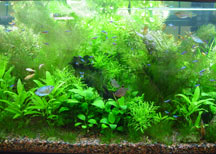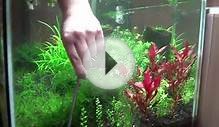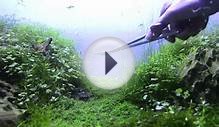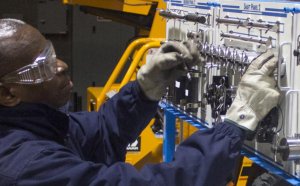
Planted Aquarium Maintenance
to create their food
(photosynthesize). They
obtain carbon from
either carbon dioxide (CO2)
or some plants can take
it from carbonate hardness (KH).
It is easier for plants
to utilize carbon from CO2,
which is naturally present
in the aquarium, but not
usually at the levels needed.
As CO2 levels disappear,
plants slow their growth, forcing
them to use the carbon
from KH, which is the ingredient
that holds pH stable. When
this buffers content is lowered,
pH levels can change dramatically,
which may severely stress
or even kill fish. Growth rates of aquatic plants are strongly correlated1 with availability of carbon and the plant's affinity for carbon uptake. Studies1 have shown that plants with the greatest carbon affinity have the greatest growth rates, whereas those with lower carbon affinity have correspondingly slower growth rates. Because carbon availability is normally the limiting factor to growth, addition of CO2 to a planted aquarium will always result in large increases in growth (assuming other critical elements are not lacking).
Without additional CO2 the growth rate will be dependent on the rate at which atmospheric CO2 equilibrates into the water. CO2 will dissolve into CO2-free water to a degree that is dependent on the air pressure, temperature, pH and bicarbonate/carbonate content of the water. The final concentration of CO2 in the water depends entirely on those factors. Once that concentration is achieved, the level of CO2 will not change unless the plants remove it or one of the other factors is altered.
Plants remove CO2 at a rate much greater than the rate at which it equilibrates into the water. So at the height of CO2 utilization, the plants limit their own growth by using up all available CO2. Because CO2 is an integral component of the bicarbonate buffer system, a drop in CO2 will necessarily result in a rise in pH. As the pH rises, the influx of additional atmospheric CO2 will be diminished by its conversion to bicarbonate.
This is offset somewhat by hard water plants that can utilize bicarbonate directly. However, without routine water changes or buffer additions (Alkaline Buffer™ or Liquid Alkaline Buffer™), this path will eventually lead to complete depletion of the KH (carbonate hardness) which will result in dramatic pH swings from day to night (5.7 - 9.6).1
 CO2 injection bypasses this predicament by delivering a constant source of CO2. Because the introduction of CO2 will lower pH, you have two options: (1) Monitor and calibrate the rate of CO2 addition to precisely match the usage by the plants or (2) use a pH feedback metering system, such as a pH controller. Option (2) is ideal because as the pH falls below a certain point, the CO2 turns off, thus avoiding catastrophic pH drops.
CO2 injection bypasses this predicament by delivering a constant source of CO2. Because the introduction of CO2 will lower pH, you have two options: (1) Monitor and calibrate the rate of CO2 addition to precisely match the usage by the plants or (2) use a pH feedback metering system, such as a pH controller. Option (2) is ideal because as the pH falls below a certain point, the CO2 turns off, thus avoiding catastrophic pH drops.
If you are not quite ready for the initial investment in a CO2 injection system but would still like to enjoy some of the benefits of adding additional carbon, there is an alternative: Flourish™ Excel. It provides a simple organic carbon molecule (similar to what is described above in the photosynthesis discussion) that plants can use as a building block for more complex carbohydrates. Because Flourish™ Excel is an organic carbon source, it does not impact pH. Even if you are already using CO2, you can still obtain a cumulative benefit by using Flourish™ Excel in conjunction with CO2.
BiographyGreg Morin is the President and CEO of Seachem Laboratories, Inc. and has been with the company since its inception over 20 years ago. He graduated from Notre Dame with a Ph.D. in organic chemistry and is actively involved in developing new and innovative products. Resources
1. Walstad, Diana, Ecology of the Planted Aquarium, Echinodorus Publishing, 1999, pp. 94-97.
RELATED VIDEO



Share this Post
Related posts
Building Construction related to the Fire Service
This textbook matches the course outline and objectives identified by the National Fire Academy s Fire and Emergency Services…
Read MoreIndustrial Maintenance Technology
Industrial Maintenance Mechanic I [3] MANF 211 - Industrial Maintenance Mechanic I 3-4-3 Basic principles and skills of…
Read More









